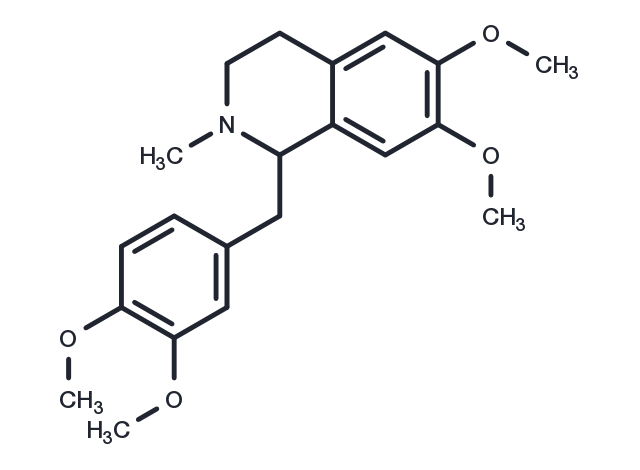Powder: -20°C for 3 years | In solvent: -80°C for 1 year


DL-Laudanosine (Laudanosine) is a recognized metabolite of atracurium and cisatracurium.

| Pack Size | Availability | Price/USD | Quantity |
|---|---|---|---|
| 5 mg | In stock | $ 42.00 | |
| 10 mg | In stock | $ 59.00 | |
| 25 mg | In stock | $ 93.00 | |
| 50 mg | In stock | $ 135.00 | |
| 100 mg | In stock | $ 197.00 | |
| 1 mL * 10 mM (in DMSO) | In stock | $ 55.00 |



| Description | DL-Laudanosine (Laudanosine) is a recognized metabolite of atracurium and cisatracurium. |
| In vivo | laudanosine, a metabolite of atracurium and a central nervous system stimulant, might increase the minimum alveolar concentration (MAC) of halothane.?These estimates were used to determine the rates of infusion that would produce steady state plasma concentrations of laudanosine of approximately 200, 400, and 800 ng .?ml-1.?Subsequent infusion of laudanosine in eight rabbits produced mean (+/- SD) steady state plasma concentrations of laudanosine of 234 +/- 56, 457 +/- 66, and 873 +/- 105 ng .?ml-1.?The control value for MAC of halothane was 1.08 +/- 0.28%.?At the lowest steady state plasma laudanosine concentration, MAC did not significantly differ from control (MAC = 1.15 +/- 0.23%, P less than 0.1).?However, at 457 and 873 ng .?ml-1, laudanosine significantly increased the MAC of halothane by 23% and 30%, respectively.?Infusion with saline in two additional rabbits did not affect MAC. Therefore, at the plasma concentrations of laudanosine found in humans after administration of atracurium, laudanosine increased the MAC of halothane in rabbits[1]. |
| Synonyms | Laudanosine |
| Molecular Weight | 357.44 |
| Formula | C21H27NO4 |
| CAS No. | 1699-51-0 |
Powder: -20°C for 3 years | In solvent: -80°C for 1 year
DMSO: 11 mg/mL (30.77 mM)
You can also refer to dose conversion for different animals. More
bottom
Please see Inhibitor Handling Instructions for more frequently ask questions. Topics include: how to prepare stock solutions, how to store products, and cautions on cell-based assays & animal experiments, etc.
DL-Laudanosine 1699-51-0 Metabolism Others Drug Metabolite DLLaudanosine DL Laudanosine Inhibitor Laudanosine inhibit inhibitor
